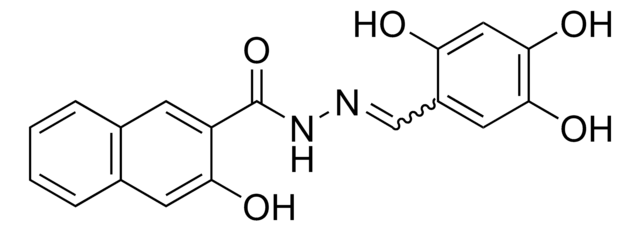Z4152
Zafirlukast
≥98% (HPLC)
Synonyme(s) :
N-[3-[[2-Methoxy-4-[[[(2-methylphenyl)sulfonyl]amino]carbonyl]phenyl]methyl]-1-methyl-1H-indol-5-yl]carbamic acid cyclopentyl ester
Sélectionner une taille de conditionnement
102,00 $
Sélectionner une taille de conditionnement
About This Item
102,00 $
Produits recommandés
Niveau de qualité
Essai
≥98% (HPLC)
Forme
solid
Solubilité
DMSO: ≥28 mg/mL
Auteur
AstraZeneca
Température de stockage
room temp
Chaîne SMILES
COc1cc(ccc1Cc2cn(C)c3ccc(NC(=O)OC4CCCC4)cc23)C(=O)NS(=O)(=O)c5ccccc5C
InChI
1S/C31H33N3O6S/c1-20-8-4-7-11-29(20)41(37,38)33-30(35)22-13-12-21(28(17-22)39-3)16-23-19-34(2)27-15-14-24(18-26(23)27)32-31(36)40-25-9-5-6-10-25/h4,7-8,11-15,17-19,25H,5-6,9-10,16H2,1-3H3,(H,32,36)(H,33,35)
Clé InChI
YEEZWCHGZNKEEK-UHFFFAOYSA-N
Informations sur le gène
human ... CYSLTR1(10800)
Application
Actions biochimiques/physiologiques
Caractéristiques et avantages
Mentions de danger
Conseils de prudence
Classification des risques
Aquatic Chronic 4
Code de la classe de stockage
11 - Combustible Solids
Classe de danger pour l'eau (WGK)
WGK 3
Point d'éclair (°F)
Not applicable
Point d'éclair (°C)
Not applicable
Faites votre choix parmi les versions les plus récentes :
Certificats d'analyse (COA)
Vous ne trouvez pas la bonne version ?
Si vous avez besoin d'une version particulière, vous pouvez rechercher un certificat spécifique par le numéro de lot.
Déjà en possession de ce produit ?
Retrouvez la documentation relative aux produits que vous avez récemment achetés dans la Bibliothèque de documents.
Les clients ont également consulté
Articles
Discover Bioactive Small Molecules for Lipid Signaling Research
Active Filters
Notre équipe de scientifiques dispose d'une expérience dans tous les secteurs de la recherche, notamment en sciences de la vie, science des matériaux, synthèse chimique, chromatographie, analyse et dans de nombreux autres domaines..
Contacter notre Service technique









